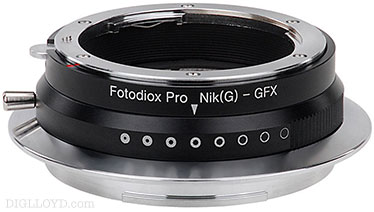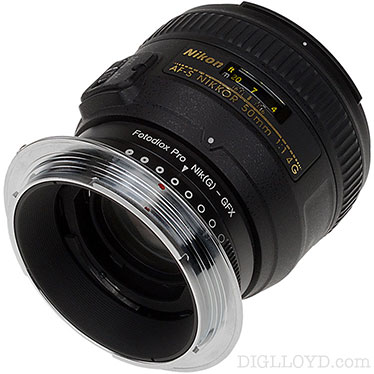Adapting Lenses to the Fujifilm GFX
Update 25 April: adapter in hand:
- No instruction manual, no warranty card, no printed material of any kind in the box.
- The Fujifilm GFX requires that Shoot Without Lens is enabled. This is a little weird, since the adapter is electronic and the camera ought to know that a lens is attached, but maybe the adapter fails to communicate properly.
- The aperture control dial on the adapter is physically tight on one end of the range (excessive resistance) and OK over the rest of the range.
- To use the aperture ring on the lens (Zeiss ZF.2), set the aperture control on the adapter to totally stopped down (leftmost dot on its aperture control ring). This yields manual control over the diaphragm via the aperture ring, allowing one to know both which aperture is in use and to use the feel and sound of clicks which aperture is chosen (click-click-click-click from wide open is f/2.8 (half stop clicks, kudos to Zeiss design).
- To use electronic aperture control with an electronic aperture, set the lens diaphragm to the locked position (if it has such a control, as do ZF.2 lenses). The adapter then controls the aperture—except that it doesn’t work correctly: nothing happens to the lens diaphragm (stays open) until the 2nd or 3rd dot on the adapter is dialed in. In other words, the adapter does not work correctly for electronic control of aperture. Manual aperture control as per the first point is the way to go for ZF.2. Otherwise, it’s a crap shoot on which aperture is actually in use.
- The utility of using the aperture ring is a key feature for me: it means I’d need a flashlight and have to peer down on top of the thing in dim conditions. No way to go click-click-click to know I’m at f/4 on an f/1.4 lens. So Zeiss lenses with aperture rings (ZF.2) are ideal.
I’d prefer an all-manual adapter myself, since that’s all I need for Zeiss ZF.2 lenses with aperture rings. But those with Canon or Zeiss ZE or Nikon G of course must have an electronic control. However, as per the point above, aperture control on the adapter doesn't work properly, so one has to guess at aperture. This product needs work just to function properly with a lens lacking an aperture ring, even if one forgoes the desire to know the aperture.
...
One last thing before I send back the loaner Fujifilm GFX is to establish how lenses for 36 X 24mm format perform on the larger 44 X 33mm sensor of the GFX.
I expect to receive the about $150 FotodioX Nikon F Lens to Fujifilm G-Mount Camera Pro Lens Mount Adapter tomorrow. In the past I have been very displeased with Fotodiox quality (had to destructively remove one by sawing it off a Zeiss lens), but I am going to give this new offering a fair trial.

The lenses I intend to check out to at least establish behavior are the following:
- Zeiss Otus 28mm f/1.4 APO-Distagon
- Zeiss Otus 55mm f/1.4 APO-Distagon
- Coastal Optics 60mm f/4 UV-VIS-IR APO Macro
- Zeiss Milvus 100mm f/2M
- Zeiss 135mm f/2 APO-Sonnar
A this point, my intent is a 'survey': what has potential and what does not and in general does does the quality hold up to a useful level.
Back in 2014, I investigated the performance of the Zeiss Touit lineup for Sony APS-C format on Sony full frame format including classic ratios like 4:5 and 1:1 and panoramic, with remarkably good results.

- Zeiss Touit 12mm f/2.8 Distagon: More than APS-C Coverage?
- Zeiss Touit 12mm f/2.8 Distagon: Usage on Full-Frame Sensor for Classic Ratios
- Zeiss Touit 32mm f/1.8 Planar: More than APS-C Coverage?
- Zeiss Touit 32mm f/1.8 Planar: Usage on Full-Frame Sensor for Classic Ratios
- Zeiss Touit 32mm f/1.8 Planar: More than APS-C Coverage?
- Zeiss Touit 50mm f/2.8M: Usage on Full-Frame Sensor for Classic Aspect Ratios
Considerations in applying a lens designed for the 36 X 24mm format on the much larger 44 X 33mm format are several:
- All lenses will vignette much more than on the 36 X 24mm frame, some excessively, some modestly. Vignetting can vary substantially depending on focusing distance (decreasing with closer focusing unless focal length shortening tricks are use). Stopping down reduces vignetting substantially.
- Just because a lens covers 44 X 33mm area does not mean the quality will be worthwhile. And even if the lens is sharp, there may be excessive field curvature or focus shift and/or aberrations that increase to greatly reduce the point spread function outside the 36 X 24mm frame. Such things might require using only at f/8 or f/11 for example.
- Color shifts from ray angle might be an issue with some lens designs.
- Planarity of the lens adapter is always a concern, as is the increased lever-arm torque on the lens mount with a heavy lens.
- Flare and uneven lighting outside the 35mm frame area.
- ... and so on.
Why anyone would bother mounting a 'dog' of a lens like the Nikon 50/1.4G on the GFX as shown in the product shot is dubious, both for very poor focusing throw and feel but also for its modest optical performance and severe flare issues. It is precisely for this reason that I feel it is worthwhile to try the best and establish the gamut of performance, so perhaps I’ll mount that Nikon 50/1.4G and see how badly or not so badly it does.

























